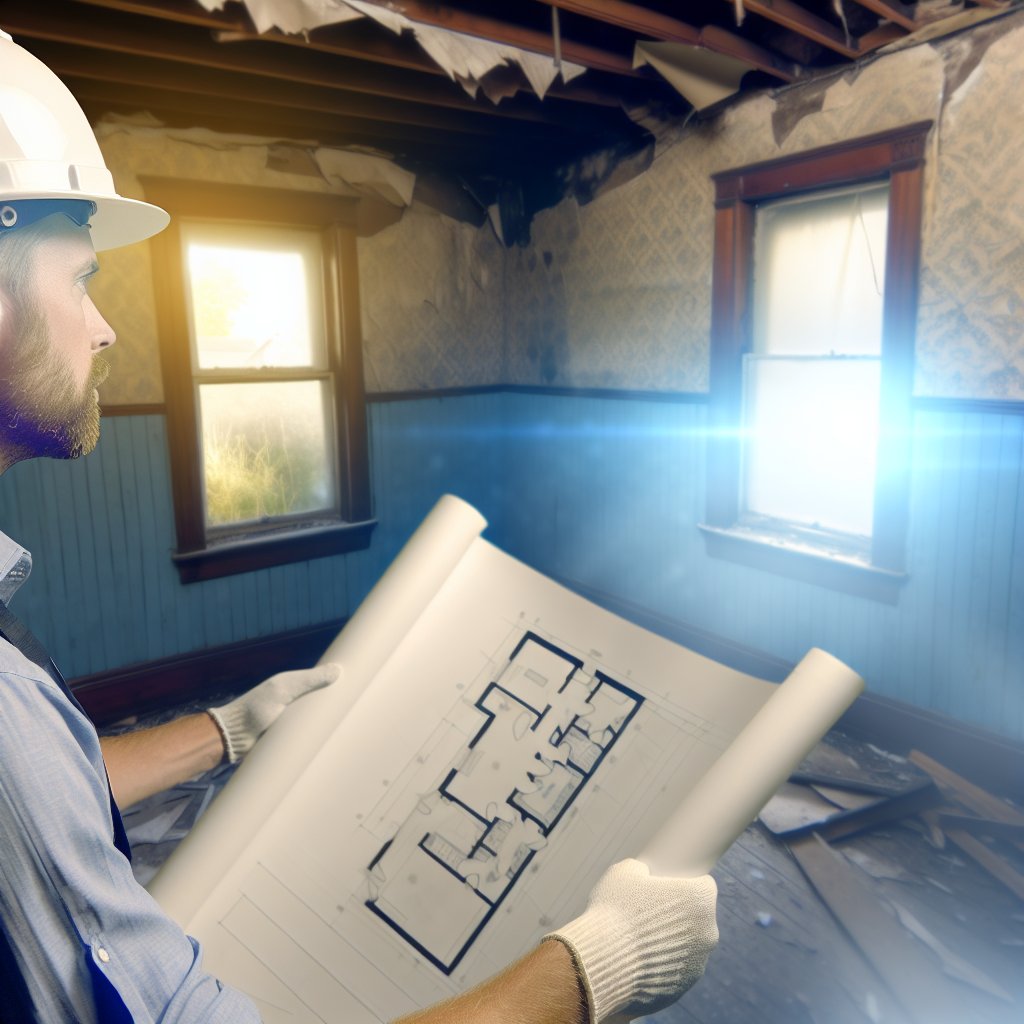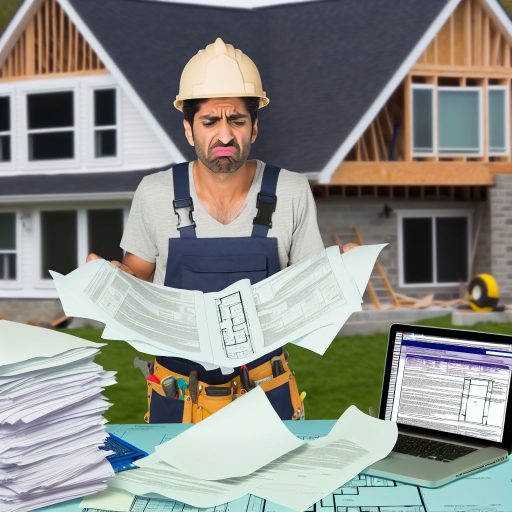Understanding the Importance of Renovation Cost Estimation for Fixer-Uppers
Setting Realistic Budgets
Accurate cost estimation helps set realistic budgets for renovations.
This practice prevents overspending and financial strain.
It allows homeowners to allocate funds effectively across various projects.
Identifying Potential Issues
Detailed cost estimation reveals potential issues in advance.
Homeowners can anticipate problems, such as structural deficiencies.
This foresight allows for strategic planning and allocating necessary resources.
Avoiding Financial Surprises
Cost estimation minimizes the risk of unexpected expenses during renovation.
When homeowners understand costs beforehand, they can avoid budget overruns.
This awareness promotes higher satisfaction with the renovation process.
Enhancing Property Value
Proper renovation adds significant value to fixer-upper homes.
Cost estimation helps prioritize projects that yield the highest returns.
Investing wisely ensures a stronger resale value in the housing market.
Facilitating Better Planning
Renovation cost estimation aids in effective project planning.
Homeowners can schedule renovations based on their budget constraints.
This planning fosters smoother project execution and reduces delays.
Transform Your Real Estate Decisions
Unlock personalized real estate insights crafted just for you. Get actionable advice designed to amplify your success.
Get StartedAdditionally, it allows for timely decision-making when challenges arise.
Key Factors Influencing Renovation Costs
Location and Property Type
The location of a fixer-upper affects renovation costs significantly.
Urban areas often have higher expenses due to labor and material costs.
Rural properties sometimes require transportation for materials and workers.
Additionally, the type of property influences the scope of renovations needed.
For example, a historic home may require specialized skills and materials.
Scope of Renovation
The extent of the renovation dictates the overall cost.
A partial renovation focuses on specific areas like kitchens or bathrooms.
In contrast, a full renovation involves structural changes and updates.
More comprehensive projects usually lead to increased labor and material expenses.
Materials and Finishes
The choice of materials greatly impacts the renovation budget.
High-end materials like granite and hardwood can escalate costs significantly.
Conversely, opting for economical materials may reduce expenses.
However, balancing quality and cost is essential for long-term satisfaction.
Showcase Your Real Estate Business
Publish your company profile on our blog for just $200. Gain instant exposure and connect with a dedicated audience of real estate professionals and enthusiasts.
Publish Your ProfileLabor Costs
Labor costs vary widely based on the skill level required.
Specialized trades such as plumbing and electrical work demand higher rates.
Hiring reputable contractors often results in better workmanship and reliability.
Nevertheless, obtaining multiple quotes ensures competitive pricing.
Permits and Regulations
Renovations often require various permits depending on local regulations.
Budgeting for permit costs is essential to avoid unexpected expenses.
Moreover, understanding zoning laws can prevent potential legal issues.
Ensuring all necessary approvals before starting a project is critical.
Unexpected Repairs
Older homes typically hide significant repair needs beneath the surface.
Issues like mold, plumbing failures, or electrical problems may arise post-purchase.
Setting aside a contingency budget is wise to address these surprises.
Being prepared for the unexpected mitigates stress and financial strain.
Types of Renovations: Cosmetic vs. Structural Changes
Cosmetic Renovations
Cosmetic renovations enhance the aesthetics of a home.
They often include painting, flooring, and updating fixtures.
These changes are relatively quick and less invasive.
Homeowners typically pursue cosmetic upgrades for immediate impact.
Moreover, they can significantly improve a property’s curb appeal.
Common examples include new countertops and cabinet facelifts.
While generally less expensive, costs can still add up.
Homeowners should budget carefully to avoid overspending.
Structural Changes
Structural renovations involve significant modifications to a home.
They address foundational changes, walls, and room additions.
These renovations can dramatically alter the layout of a space.
Often, they require professional contractors and permits.
Consequently, structural changes typically come with higher costs.
However, they can add substantial value to a property.
Examples include adding a second story or expanding a kitchen.
Investing in structural upgrades can transform a home’s functionality.
Comparative Analysis
Homeowners should evaluate the goals of their renovation project first.
Cosmetic changes may suffice for improving appearance alone.
Showcase Your Real Estate Business
Publish your company profile on our blog for just $200. Gain instant exposure and connect with a dedicated audience of real estate professionals and enthusiasts.
Publish Your ProfileOn the other hand, structural changes may be necessary for more space.
Potential buyers often look for both types of improvements.
Therefore, a balanced approach may yield the best results.
Ultimately, understanding each type aids in cost estimation.
This knowledge helps in making informed renovations decisions.
Explore Further: How to Incorporate Smart Technology During Home Renovations
Detailed Breakdown of Typical Renovation Costs
Understanding Key Renovation Elements
Renovation costs vary significantly based on project type.
Each element contributes to the overall budget.
Consequently, evaluating each aspect is crucial.
Common Areas for Renovation
Typically, kitchens and bathrooms require the most investment.
On average, kitchen renovations can exceed $25,000.
Bathroom updates often fall between $10,000 and $15,000.
Living spaces may need new flooring or paint, costing around $5,000 to $10,000.
Kitchens
Kitchen upgrades involve cabinets, countertops, and appliances.
Cabinet replacements alone can cost more than $10,000.
High-quality countertops add another $3,000 to $5,000.
New appliances can further increase the budget by $2,000 to $10,000.
Bathrooms
Bathroom renovations often include new fixtures and tiles.
Shower installations can run from $1,500 to $5,000.
Vanities and sinks typically cost around $500 to $3,000.
Moreover, flooring selections impact the overall expense as well.
Essential Structural Improvements
Foundation repairs are vital and can be substantial.
Foundation work may range from $2,000 to $7,000.
Roof repairs are also essential for long-term stability.
Homeowners can expect to pay $5,000 to $10,000 for new roofing.
Permits and Professional Fees
Factoring in permits is essential for renovations.
Permit costs can range from $300 to over $1,000.
Hiring professionals also impacts the project budget significantly.
Contractor fees often account for 10% to 20% of renovation costs.
Unforeseen Expenses to Consider
Homeowners should be prepared for unexpected costs.
Showcase Your Real Estate Business
Publish your company profile on our blog for just $200. Gain instant exposure and connect with a dedicated audience of real estate professionals and enthusiasts.
Publish Your ProfileHidden issues like mold or electrical problems can arise.
Budgeting an additional 10% to 15% can mitigate financial strain.
Final Thoughts on Budgeting
Accurate cost estimation requires careful planning.
Understanding necessary expenses helps homeowners stay on track.
Ultimately, knowing the breakdown enables informed financial decisions.
Gain More Insights: Optimizing Budget Planning Through Renovation Cost Estimation For U.S. Investors
Methods for Accurately Estimating Renovation Expenses
Initial Consultation
A thorough consultation starts your renovation journey.
Engaging with a skilled contractor can set realistic expectations.
They assess the property and discuss your vision clearly.
Detailed Cost Breakdown
Categorize your costs for better clarity.
Include materials, labor, and any necessary permits.
Consider additional costs for unexpected repairs.
Research and Comparison
Conduct thorough research on material prices.
Visit local hardware stores and online suppliers for data.
Gather multiple quotes from contractors for labor costs.
Creating a Contingency Fund
A contingency fund is essential for managing unexpected expenses.
Typically, allocate 10 to 20 percent of your budget.
This fund helps to absorb unforeseen costs effectively.
Utilizing Renovation Software
Renovation software simplifies expense tracking and estimation.
Many tools provide templates for various projects.
Seek out user-friendly options that suit your needs.
Consulting with Real Estate Experts
Engage with real estate professionals for current market insights.
Their expertise can help validate your budget choices.
They often provide recommendations for valuable upgrades.
Reviewing Similar Projects
Investigate renovation costs of similar homes in your area.
This data gives you a realistic baseline for your estimates.
Online forums and local listings can be valuable resources.
Discover More: Guide To Navigating Legal Challenges In Property Development
How to Prioritize Renovation Projects Based on Budget
Assess Your Total Budget
Start by determining your total renovation budget.
This budget should include all expected costs.
Showcase Your Real Estate Business
Publish your company profile on our blog for just $200. Gain instant exposure and connect with a dedicated audience of real estate professionals and enthusiasts.
Publish Your ProfileConsider both labor and materials in your calculations.
It helps if you have a contingency fund for unexpected expenses.
Identify Essential Repairs
Focus on projects that address essential repairs first.
Structural issues, roof repairs, and plumbing must take priority.
These repairs ensure the safety of your home.
Addressing them early avoids higher costs later.
Evaluate Cosmetic Upgrades
After essential repairs, assess cosmetic upgrades.
Consider how these upgrades add value to your home.
Paint and flooring can drastically change aesthetics.
They may not be urgent but can enhance livability.
Understand Local Market Trends
Research local market trends when prioritizing renovations.
Know what features potential buyers value most.
Focus on upgrades that offer high return on investment.
Kitchen and bathroom remodels often provide the best returns.
Plan for Energy Efficiency
Integrate energy-efficient upgrades into your renovation plans.
These upgrades can lower utility bills over time.
Consider newer windows, insulation, and appliances.
Energy-efficient homes attract more buyers in the market.
Set Realistic Timelines
Establish realistic timelines for each renovation project.
Consider how each purchase and renovation aligns with your budget.
Avoid rushing projects to maintain quality and control costs.
Sufficient planning leads to a smoother renovation process.
See Related Content: DIY Renovation Tips For Maximizing Real Estate ROI

Contingency Planning: Why You Need a Buffer for Unexpected Costs
Understanding Contingency Planning
Contingency planning is crucial in renovation projects.
Unexpected costs often arise during the renovation process.
These surprise expenses can derail your budget quickly.
Having a buffer helps manage these unforeseen costs.
Establishing a Financial Buffer
Experts recommend setting aside a contingency fund.
This fund should ideally be 10% to 20% of your total budget.
The exact percentage depends on the project’s complexity.
Showcase Your Real Estate Business
Publish your company profile on our blog for just $200. Gain instant exposure and connect with a dedicated audience of real estate professionals and enthusiasts.
Publish Your ProfileA higher percentage is prudent for older fixer-upper homes.
Consider your specific renovation needs when determining the amount.
Common Unexpected Costs
Several unexpected expenses often surprise homeowners.
Structural issues can arise once walls are opened.
Hidden plumbing or electrical problems frequently emerge as well.
Additionally, permitting issues can add unplanned costs.
It’s wise to prepare for these potential pitfalls.
Benefits of Having a Contingency Plan
A well-planned contingency fund reduces stress.
It allows for more flexibility in your budget.
You can make necessary adjustments without panic.
Moreover, it reinforces confidence in your renovation decisions.
Ultimately, this leads to a smoother project execution.
How to Create Your Contingency Plan
Start by evaluating your renovation project scope.
Assess the likelihood of encountering unexpected issues.
Then, estimate potential costs based on similar projects.
Make sure to document and track all your expenses.
Regularly review your contingency fund as the project progresses.
Tips for Finding Reliable Contractors and Getting Accurate Quotes
Identifying Potential Contractors
Start by asking friends and family for recommendations.
Check local online reviews for contractors in your area.
Visit home improvement stores to find bulletin boards with postings.
Consider using social media groups focused on home renovation.
Verifying Credentials
Always verify licenses and insurance coverage before hiring.
Request references from previous clients for feedback.
Contact local trade associations to check affiliations.
Obtaining Multiple Quotes
Gather at least three quotes to compare pricing and services.
Ensure that each quote covers the same scope of work.
Ask detailed questions to clarify any uncertainties.
Evaluating Quotes Carefully
Look beyond the numbers; consider the quality of materials mentioned.
Assess the proposed timeline for completion as well.
Ensure all labor and material costs are itemized in the quotes.
Showcase Your Real Estate Business
Publish your company profile on our blog for just $200. Gain instant exposure and connect with a dedicated audience of real estate professionals and enthusiasts.
Publish Your ProfileCommunicating Effectively
Clearly communicate your vision and expectations to the contractor.
Discuss any specific needs or concerns you have upfront.
Maintain open lines of communication throughout the project.
Finalizing the Contract
Read the contract carefully before signing anything.
Ensure all terms are clearly defined, including timelines and costs.
Include a clause for change orders to manage unexpected expenses.
Case Studies: Successful Fixer-Upper Renovations and Their Costs
Overview of Case Studies
This section explores various successful fixer-upper renovations.
Each case study highlights renovation costs and processes.
Homeowners transformed these properties into dream homes.
Case Study: The Johnson Family’s Bungalow
The Johnson family purchased a 1920s bungalow in need of updates.
They aimed for a modern aesthetic while preserving charm.
Renovation costs totaled $150,000.
This included structural repairs, new roofing, and a kitchen remodel.
They replaced old plumbing and electrical systems.
Increased energy efficiency became a priority for the family.
The completed home sold for $300,000 after renovations.
Case Study: Smith’s Victorian Restoration
The Smiths bought a neglected Victorian home in a historic district.
They needed to restore original features while updating amenities.
Total renovation costs reached $250,000.
Repairs included restoring hardwood floors and crown molding.
The Smiths installed a modern heating and cooling system.
This project improved the home’s functionality and aesthetic value.
Their property now attracts many admirers and potential buyers.
Case Study: Tech-Savvy Renovation by the Martinez Family
The Martinez family purchased a mid-century modern home.
They integrated smart home technology into their renovation plans.
This renovation cost approximately $175,000.
They revamped the kitchen and added energy-efficient appliances.
The family prioritized eco-friendly building materials.
This approach enhanced the home’s contemporary appeal.
The overall market value skyrocketed post-renovation.
Showcase Your Real Estate Business
Publish your company profile on our blog for just $200. Gain instant exposure and connect with a dedicated audience of real estate professionals and enthusiasts.
Publish Your ProfileLessons Learned from Fixer-Upper Projects
Careful planning is crucial for budget control.
Homeowners should prioritize necessary repairs first.
Understanding the local real estate market helps in pricing renovations.
Creative solutions can save costs while achieving aesthetic goals.
Collaboration with experienced contractors can enhance project success.
Post-renovation, these homes often exceed initial investment values.
Additional Resources
203(k) Rehabilitation Mortgage Insurance Program Types | HUD.gov …




